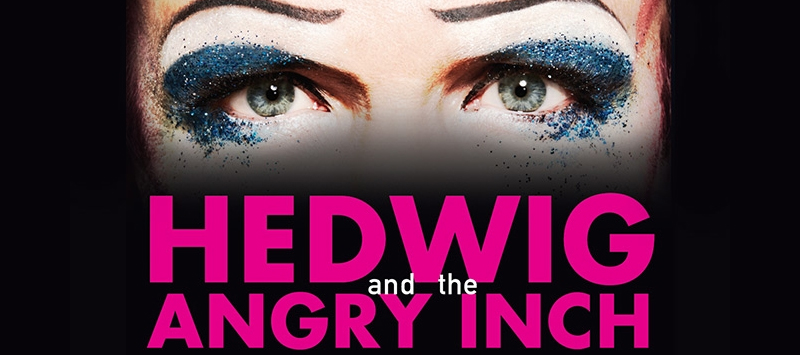As we were taking our seats at the AT&T Performing Arts Center’s Winspear Opera House in Dallas for the traveling Broadway production of Hedwig and the Angry Inch, my mother turned to me and commented on the growing crowd.
“I wonder if lots of these people realize what they’re about to see.”
Funny coming from her, since it would be her first time seeing the show. But since her daughter is a superfan—a Hedhead—she was up to speed on a few things in advance: I described it beforehand as going to a rock concert where the lead singer is having a nervous breakdown on stage.
After seeing the NYC production alone, I offered to take my mom to the local show on a whim and she was surprisingly excited to go. I’ll admit that I was the slightest bit nervous about her reaction to it; not because I’d be offended if she disliked it, but because it’s a far cry from the types of media she enjoys (she’d prefer a Maroon 5 concert). The show’s titular character uses vulgar humor throughout the show, in addition to outright insulting her band and the audience at times. In truth, many people in the theatre that night might not have known that they were about to see an in-your-face rock show disguised as a musical.
After the explosive opening song, when an audience member took his front-row seat late, Hedwig paused her monologue to say, directly to him, “Are you fucking kidding me?” My mom laughed as loudly as I did, and I started to have a good feeling about the rest to come.
Of course, to a fan like me, Hedwig is so much more than its signature crass humor. It’s a celebration of music, of queerness, of love and loss, and ultimately, of finding wholeness within yourself instead of looking outward for completion. Having seen the show on Broadway in New York—during both Neil Patrick Harris’s opening run and co-writer John Cameron Mitchell’s return to his own iconic role—I was intrigued to see what the new traveling production would bring.
No performer on the planet could ever surpass Mitchell as Hedwig—when he’s on stage, fans are seeing Hedwig, the character, in real life. As the co-creator and original Hedwig, he simply owns the role, and seeing him perform live is singularly breathtaking. (His final show on Broadway is not only the best live musical I’ve seen, it’s also the best concert I’ve ever attended.) For that reason, comparing him with any other performer in this role is moot. But the current Hedwig, Euan Morton, brings great energy and humor to the production and is absolutely worth seeing—he even surpasses Harris, in my view. Morton really shines on the slower, softer numbers, and managed a pitch-perfect “Midnight Radio,” the soaring, moving final song. It’s maybe the most emotional and powerful moment in the show, following Hedwig’s final breakdown and violent removal of her clothing, so she stands before the audience nearly naked and sings, finally, of self-acceptance.
The most beautiful thing about the traveling show might be that it will inevitably create more Hedheads. This is a culty fandom that spans generations, starting all the way back in 1998, when Mitchell and composer/lyricist Stephen Trask brought their odd little show to the Jane Street Theatre for its original Off-Broadway run after ironing out the details in some smaller venues. When the film was relased in 2001, the already passionate fanbase expanded even more.
The last time I traveled to New York City, it was for Mitchell’s final two nights in his Broadway run, and it would become the single most memorable weekend of my life. I met and befriended many other fans—we shared stories and jokes, sang songs, and celebrated the weird, wonderful show that had brought us together. I’ve never experienced anything quite like the gathering of Hedheads at the Belasco Theatre. I even made a skirt that I decorated with lyrics and quotes from the show, with my favorite lyric front and center: “Know in your soul / Like your blood knows the way / From your heart to your brain / Know that you’re whole.” The lyric, from “Mightnight Radio,” is special to many Hedheads: After spending so much of her life searching for her “other half,” Hedwig has finally come to understand that she is already a whole person. I was lucky enough to have my skirt signed by Trask, who kindly stopped to speak with lingering fans as he emerged from the theatre hours after Mitchell’s final show.
I wasn’t alone in dressing up that weekend—everywhere I looked, other fans paid homage to the show with cosplay and special outfits. I was with my people. Over late-night snacks at a nearby bar, we talked about how awkward it can feel to explain our love of Hedwig to people who aren’t familiar with it. But amongst friends, we didn’t have to explain, because we all knew. We were on the same wavelength, and many of us have stayed in touch. I’d like to think that the common, glittery thread connecting us will withstand space and time.
I first discovered the Hedwig film in college after more than one friend recommended it, saying they were sure I’d enjoy it. I remained skeptical, though: Would I really like this “rock musical” as much as other glam rock films like Velvet Goldmine? When I finally watched the movie, I fell head-over-heels in love during the opening song—the sexy, catchy, explosive “Tear Me Down”—and never looked back. (Velvet what?) The movie goes on to follow Hedwig, an “internationally ignored song-stylist” from East Berlin who was born Hansel and changed identities/genders in order to travel to the US as an American soldier’s wife. From there, Hedwig finds herself abandoned in a Kansas trailer park and eventually forms a band: The Angry Inch, a tongue-in-cheek reference to the results of the botched “sex change” Hedwig underwent before leaving Germany. The stage show itself takes place years later, and Hedwig recounts her tragic yet humorous tale to the audience in between (and through) musical numbers.
I have to note that I was thrilled to see that in the Fort Worth Star-Telegram’s piece announcing the show, the writer explains how Hedwig’s identity has been understood in different ways over time—in years past, she was often described as a trans woman, but that doesn’t tell the whole story. Hedwig is someone who is caught between genders and identities, a state of being compared in the show to her home of Berlin, a town “split in two” by its wall.
Mark Lowry writes:
Hedwig, the character originally created by John Cameron Mitchell and Stephen Trask in downtown Manhattan drag and punk bars in the mid-1990s, defies pigeonholing, which is perhaps why the marketing people behind the tour of the recent Broadway production make it known that she should be referred to as genderqueer, an encompassing non-binary term that covers the gamut.
“To me she didn’t choose to be transgender. She doesn’t speak for any trans movement. She’s a weird accidental figure,” says Mitchell in an interview about the tour. . . . “She’s not a wall or a bridge, she’s some in-between thing.”
Although it’s anyone’s guess how Hedwig would describe herself (aside from “tired,” maybe), genderqueer does seem to me to be the best fit based on what we know of her story. So, as a fan, I appreciate the updated marketing language. Hedwig, of course, was pressured into “becoming” a woman; it wasn’t something she sought out—but she also eventually enjoys and accepts her identity as a glam rock chick. In the end, it’s unclear what the future holds for Hedwig, but we know that she’s made peace with herself and those around her to some degree.
Leaving the opera house in Dallas, I wondered what my mom’s reaction would be to the spectacle she’d just seen. As it turns out, she really enjoyed it, loved the songs, and now wants to watch the film to better understand the story.
Have I created another Hedhead? I can only hope.
Hedwig and the Angry Inch runs through February 12 at Winspear Opera House.

